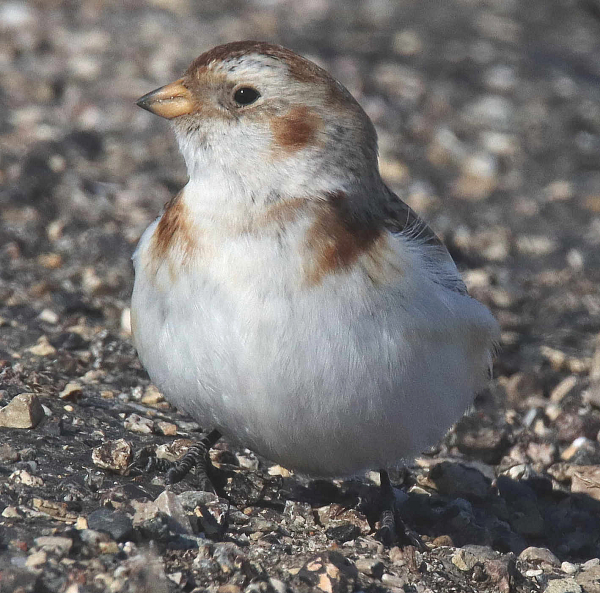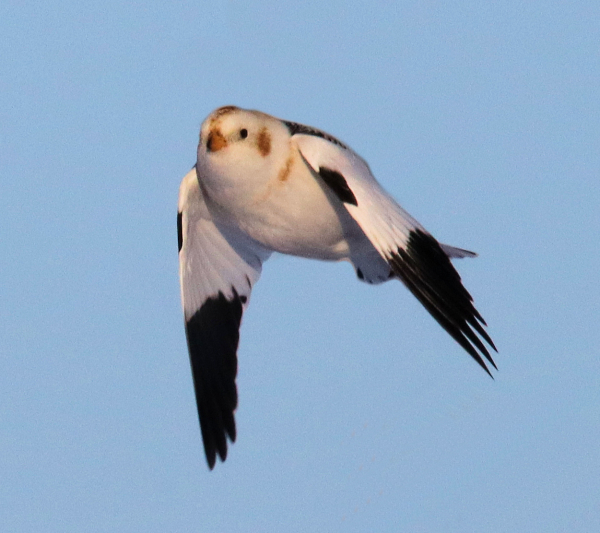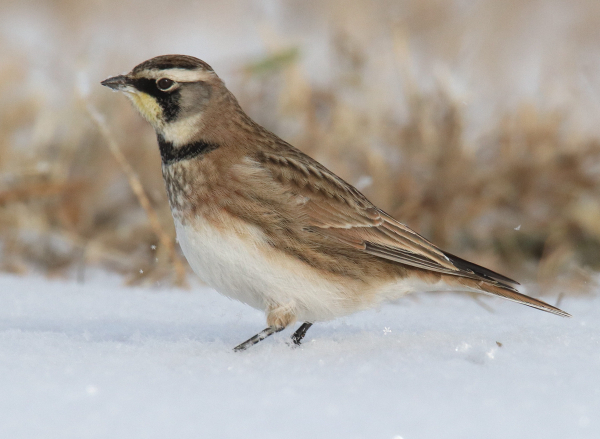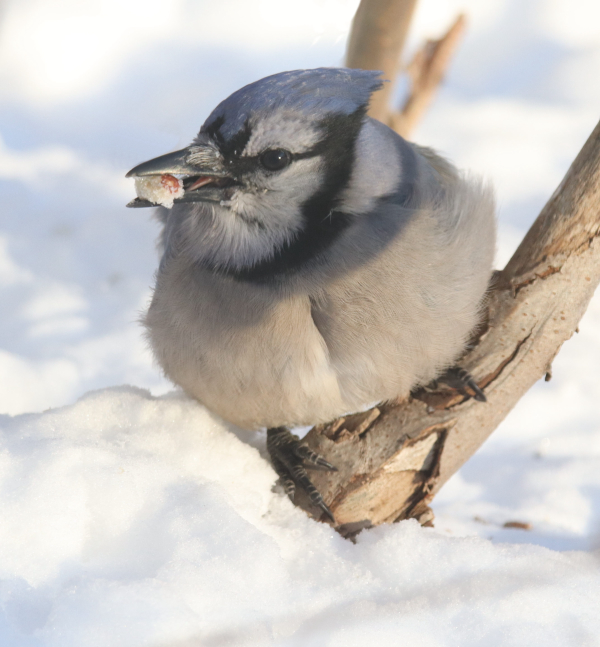
The arrival of flocks of Snow Buntings and Horned Larks marked a change in local avifauna.

A chance to focus on a different species and try to get a variety of photos added a lot to local birding last week.

Horned Larks provided a second songbird species to photograph in the field.

Will last Thursday’s Blue Jay return? Here it retrieved a shelled peanut it cached earlier.
|
Ten Seconds! That’s all the time you get sometimes. It actually might have been more like 6 seconds, but as I looked up I gasped and froze in place. A Northern Shrike was facing me just outside my bay windows, perched on a shepard’s hook at my feeding station in the same position as the Harris’s Sparrow I photographed last week. I quickly reached for my camera at arm’s length, carefully raised it and pressed the shutter button to focus on the shrike. In the meantime, the shrike turned to look away, but I took a series of photos hoping it would turn more to the side.
And then it flew. But wait, it looked like it perched just beyond the windows, and sure enough it did. I took a couple photos as it repositioned again, until it flew to a higher, more open perch to face me. But there the window angle was wrong and I couldn’t get a sharp focus, and then it flew past me one more time and out of sight to the west. Wooo! The best photos I managed were of the back and tail of the shrike as it looked for avian prey a few feet beyond my windows. Oh well, it was a magic jolt of excitement during Saturday’s cloudy sunset – a great bird sighting!
I managed my best portrait-type photo of a Northern Shrike earlier this winter, and while this yard bird photo would have been glorious too, it was an exciting observation and photo attempt nonetheless. It’s interesting that after seeing more Northern Shrikes than ever before during December, shrikes have been off the radar for the past month. But this week it appears northern birds have been pushed into this area by north winds and Arctic cold, at least 1 Northern Shrike among them.
It all started Wednesday, when in spite of a couple telltale warning signs, including the fact that my car wouldn’t start and my house’s water line was frozen (that’s to be expected when the temperature dives below –20 around here [that’s 50+ degrees below freezing!]. Even so, I needed to break away and do my weekly shopping, and follow through on a planned to visit with my great friend Mike. It took a couple extra hours to get on the road, but almost immediately I encountered a flock of 13 Snow Buntings, a species I hadn’t seen for several weeks – hmm. Usually, that indicates more flocks are in the area, and indeed, 2 miles north another dozen Snow Buntings flushed from the roadside.
There would be 4 more Snow Bunting flocks along the next 10 miles, numbering an estimated 2, 25, 7, and 8. Together the 6 flocks numbered about 63 Snow Buntings, which was a pretty exciting change from the previous weeks when no birds of any kind were the norm during birding drives in the area. Adding to the buntings, there was also a big influx of Horned Larks along the same 14-mile stretch of rural highway, numbering 12 flocks that totaled about 101 larks. But that’s where the fun ended, for the next 100 miles, there were no other birds along the way to Fargo aside from 1 flock of Horned Larks about 25 miles north of the last “local” flock. At the southwest edge of Fargo I checked my usual partridge hangouts and did see 5 Gray Partridges before enjoying a spirited visit with Mike.
The Snow Buntings are obviously originating from the Arctic, and I would bet these flocks of Horned Larks probably originated from there too, pushed south from Canada by the Arctic cold front that pressed into North Dakota and surrounding states. But why would these winter flocks of songbirds be limited to my local area? I would surely do a little field study the following day, especially to see if flocks of these birds continued south of my office.
I was also excited about trying to photograph Snow Buntings in particular, and Horned Larks, so after a good night’s sleep I headed out to see if the Arctic songbirds were still in the area. I passed by the location where I saw the first flock the previous afternoon without a bird to be seen, but a half-mile ahead there was a dandy flock of Snow Buntings numbering about 30. There was another flock of about 20 a mile-plus ahead, so I was convinced there were as many or more of the new arrivals in the area at that point. I thought about trying some photographs, but this was the busiest paved road in the area, and I expected the next bunting location would be a safer photo spot with next to no passing vehicles.
It was interesting that like the other 2 flocks and the next one was positioned in the same general area as I observed flocks the previous afternoon. The third flock changed in size during the 40 minutes I parked where Snow Buntings foraged along the shoulder area. It was interesting to see how the birds foraged with the north wind at their backs, working their way slowly in my direction. I took a wealth of photographs of buntings as they worked their way into the open, but darn those birds moved quickly, turning their heads, looking up then back down. It all made for some fast-paced photography.
At that point my photo interests were fairly satiated, so I thought I would retrace my route back to my office, then head a few miles south to see if there were Snow Buntings in that direction too. Almost immediately I flushed a flock of 5 Horned Larks, we’ll say a quarter-mile south of home. But at 2 miles my jaw dropped as a huge flock of Snow Buntings exploded into a cloud above an open field near the road. It was certainly the largest flock of buntings I’ve seen this winter, numbering more than 300. As it turned out, I didn’t venture any farther south, feeling like I hit the jackpot right there.
I spent the next 45 minutes in the company of the huge flock, watching their foraging behavior and movements as they continued to fluidly sweep across a landscape covered with a light blanket of snow. It was quickly evident that the huge flock of Snow Buntings was flowing across the landscape feeding en masse and moving in waves, ever-progressing across and above the ground. It reminded me of a big flock of Snow Geese feeding in a field and their crowd-sized movements.
I took a number of photographs to try to show the flocking behavior, but with limited success. Even so, it was a dramatic scene, one that gave me another insight into Snow Buntings, and it made me wonder if this was part of migration behavior, with smaller flocks breaking away when they find a suitable location to spend more time – the kinds of flocks I usually see numbering from 2 to 50 or so. I’ll hafta look into that by reading the “Birds of the World” species account on Snow Buntings. Halfway home I photographed a colorful male Ring-necked Pheasant set off against the snow – with 3 Horned Larks nearby. So many birds, so close to home has been a Big change from just a few days ago – and from recent weeks – it’s exciting!
A Jay Equation
As I was parking my car in front of my house, I took a look at my feeding station, and didn’t see anything out of the ordinary at first glance. But a second glance revealed a Blue Jay perched near my bay windows near ground level, seemingly appreciating the sunshine and wind break. I backed up a bit to be in better position in case it visited the platform feeder. It wasn’t the first time I had seen a Blue Jay at the feeders Thursday; one perched above the feeders for a moment earlier in the morning, and one grabbed a shelled sunflower seed from the platform feeder 15 minutes afterward. Were these 3 sightings of the same bird? I think so, judging from the lack of Blue Jay sightings and that jays are usually social when there is more than one of them.
That brings up a crazy sequence of Blue Jay sightings: It turns out that this Thursday sighting was preceded by a single jay sighting the previous Thursday with no jay sightings in between. OK, nice; but keep in mind that 12 days before the first Thursday sighting I had a Sunday Blue Jay sighting, and that was the third consecutive Sunday jay sighting, with no jay sightings other days of the week. Therefore, in the past 5 weeks, I had 3 consecutive Sunday-only Blue Jay sightings followed by 2 consecutive Thursday-only Blue Jay sightings with no jay sightings on other days. Quite an unusual blue jay story; now the question is: What’s next?
Back to the most recent Thursday jay observation: As I watched the Blue Jay displaced some House Finches from the platform feeder, where it ate a couple seeds, then grabbed a shelled peanut, which it took to a perch on a bare sumac tree near the snow line. To my surprise, the jay slyly slipped the peanut into the snow next to the base of the tree where it met the snow line, hopping to another low perch outside a bay window. I stayed in my car, photographing the Harris’s Sparrow and a couple Dark-eyed Juncos, while the jay appeared to begin napping. Although birds don’t sleep like humans, as I watched the jay clearly appeared to be “bird sleeping” a few seconds at a time.
With my camera still in hand, I entered my house and stepped into the bay end of my living room, where I could see the Blue Jay still perched just a few feet away, seemingly napping intermittently in the sunlight. As I watched and took a couple photos, the jay seemed to lively up and returned to its previous perch where it retrieved the peanut it cached there and began eating. At that point, something flushed the assembled birds including the Blue Jay, and it made me wonder if the jay was now comfortable enough to stay in the immediate area for more than a single day at a time; but Friday, there were no jay sightings, regrettably. When will one reappear? Next Thursday? We’ll see.
More Buntings & Shrike Attacks
Saturday afternoon I drove south 10 miles and north a like distance to check on Snow Buntings and Horned Larks, but hoping to see the mega-flock of buntings, there was not a bunting to be seen south of my office – only a very few Horned Larks numbering from 1 to 5. Even so, I double-checked for flocks to the north, where the 3 flocks I encountered Thursday were still in their respective areas, and there was even a fourth flock adjacent to my friend Wendell’s farmstead. Weather conditions weren’t conducive for photography with light snow blowing in lines formed by a stout north wind. I tried anyway, but the 2 flocks I approached weren’t abiding, which underlined how lucky I was to have a cooperative flock to photograph Thursday.
Jumping ahead to Monday, after another sub-20 below night, when I least expected it I looked up to see a bright white, gray and black Northern Shrike looking in my direction as it perched outside my bay windows. Before I could reach for my camera, it flew toward my backyard, so I cautiously slipped forward into the bay and peered east. The shrike few up to an eye level perch, so I photographed until it exited out of sight. A few minutes later I checked back and sure enough, there was the shrike again, but it bolted in the previous direction.
This time I sat down in the bay, facing east as I sat in my grandfather’s antique wooden rocking chair, and that’s when I noticed a pinkish shine near the base of a big pile of branches that I’ve created as a backyard habitat element for birds to get some relief from the wind or for an overnight roost site. I looked through my binoculars and saw the pink was the pink meat of a House Sparrow, an apparent victim of the shrike. No wonder it was returning to the location; in fact, as I looked away I noticed a white spot on an elm tree branch – the Northern Shrike. Before I could raise my binoculars again, the shrike flew rapidly toward me, passing within 3 feet of my right arm – ha!
I watched for the shrike again out of the corner of my eye as I worked, but didn’t see it again until I was about to slip outside. That’s when I saw the shrike diving into view, passing by my bay windows, headed toward the pile of branches. Even before I reached the bay section of my living room I heard a screeching sound – and there was the shrike, holding another sparrow down – soon to be food. After returning from a short birding drive a couple miles south of home, as I parked I thought I saw a shrike-ish bird land in the tree above me. As I exited my car, there was the shrike, flying on the heels of another songbird, with the 2 birds making a wide aerial circle within view and passing close to my feeding station and branch pile before continuing out of site. Wow, how many sparrow-sized birds does it take to fill this shrike’s hunger?
The sudden appearance of large and small flocks of Snow Buntings and Horned Larks in the area hint at changes in the avian landscape, maybe more birds will filter in from the Arctic or boreal regions to the north – or maybe the first migrants from the south will be next? We’re getting closer and closer to March, so a dramatic turn toward spring can’t be too far off, regardless of what the Ground Hog said. Enjoy the week ahead and the birds you encounter!
Article and Photos by Paul Konrad
Share your bird sightings and photographs at editorstbw2@gmail.com